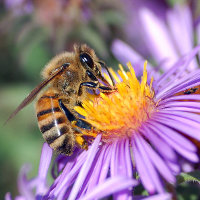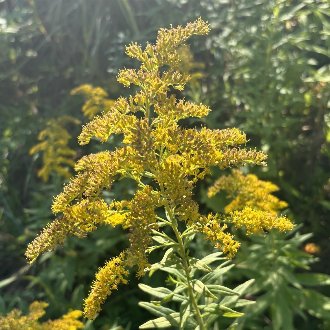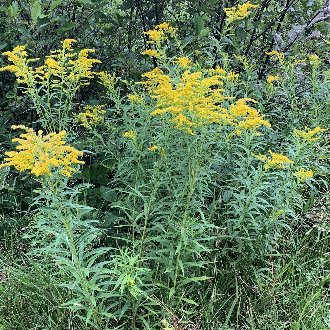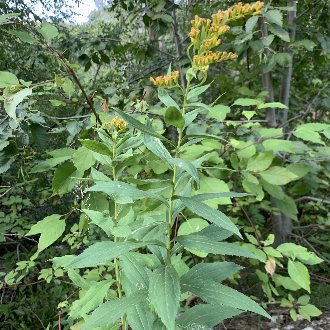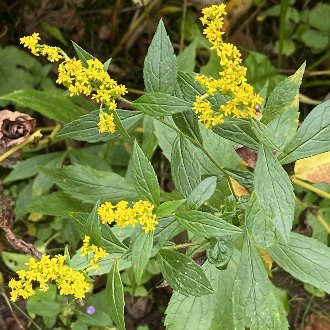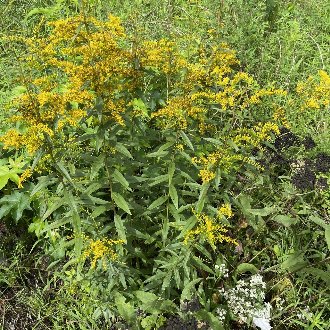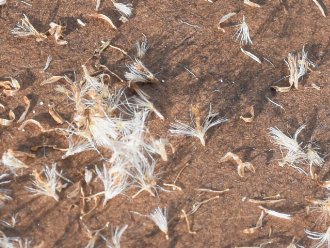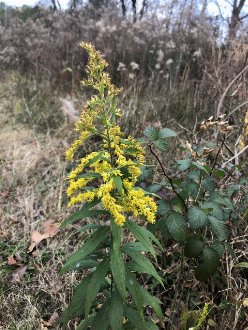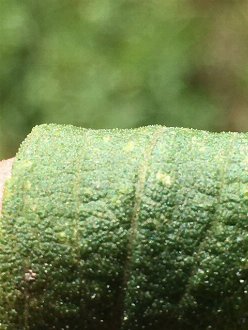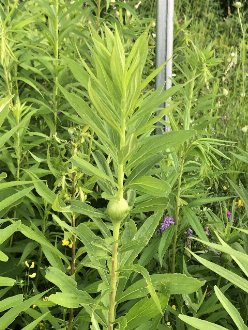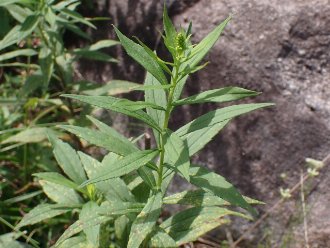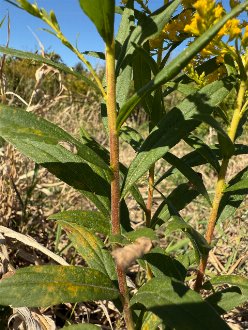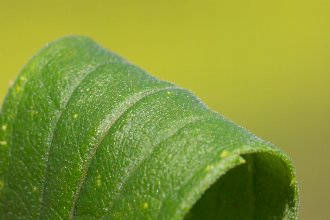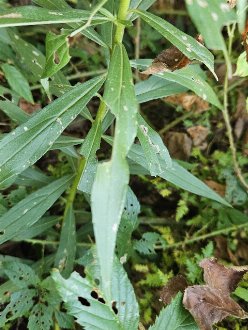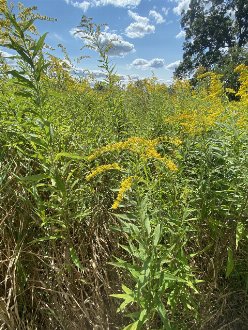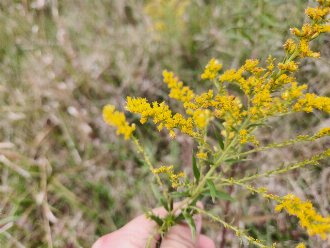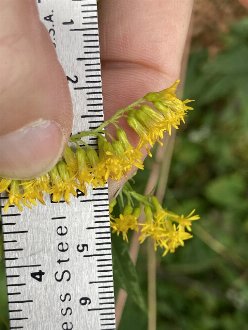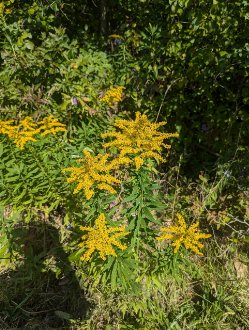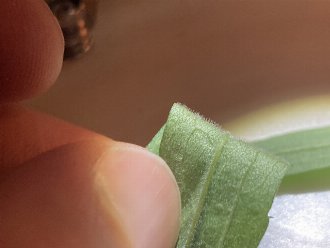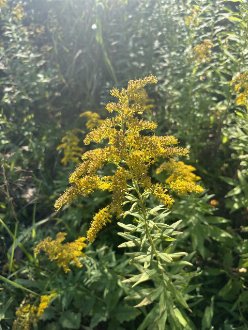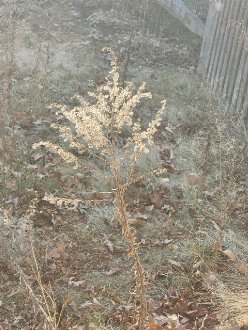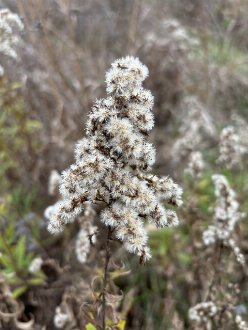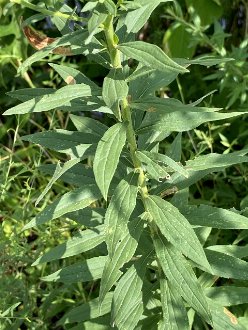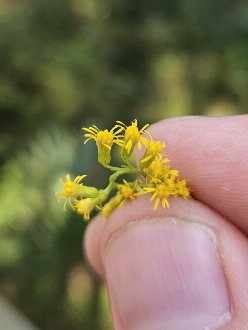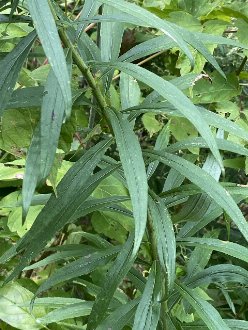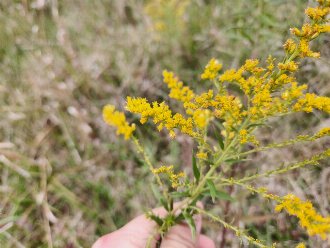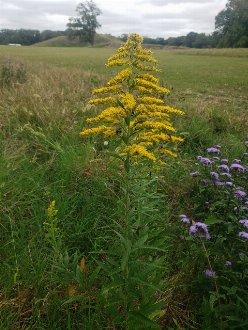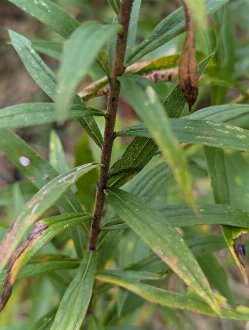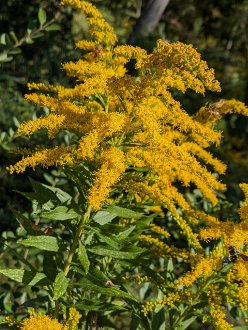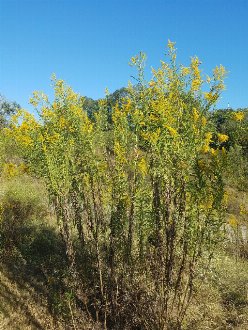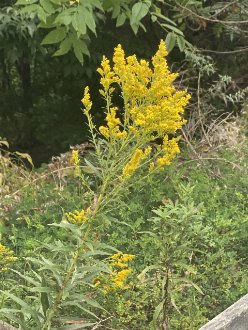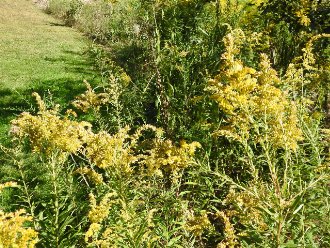Tall Goldenrod (Solidago altissima L.)
Also known as late goldenrod.
Many older authorities lump this in with Canada goldenrod (Solidago canadensis). We follow the treatment of POWO, FNA, and BONAP in separating them.
↑Summary
A common, aggressive perennial of rich, sunny, disturbed sites, native to a wide range across North America.
↑Range - Expand
| Legend | Color |
| Native | |
| Native or Not Present | |
| Introduced or Not Present |
This tentative map is based on our own research. It may have limited data on Canada and/or Mexico, and there is some subjectivity in our assignment of plants as introduced vs. expanded. Read more in this blog post.
Although this plant occurs somewhere in each of these regions, it may only occur in a small part of some or all of them.
↑Similar Plants
↑Habitat
Tall goldenrod is found in a wide variety of sunny, disturbed habitats. Natural habitats include meadows, prairies, woodland edges, large woodland clearings, shorelines, limestone barrens, and recently burned sites. Especially in the humid eastern portion of its range, it is often more common in anthropogenic habitats, including roadsides, railroads, weedy field margins, abandoned cropland, vacant lots, industrial ground, and suburban gardens.
In much of its range, it prefers dry to mesic conditions, but it is a generalist and can be found on a wide variety of sites. In the northeast, it is more restricted to warm, dry sites and is replaced by Canada goldenrod (Solidago canadensis) on mesic sites. In the south and west of its range where Canada goldenrod is absent, tall goldenrod becomes more common on mesic to moist sites including floodplains, marshes, and ditches, but throughout its range it is replaced by giant goldenrod (Solidago gigantea) on the lowest, wettest sites.
It prefers soils that are nutrient-rich but tolerates patchy soil fertility, as its rhizomatous habit allows it to access water and nutrients where available, and cycle them to stems that can access sunlight. Although it colonizes sunny, disturbed sites with exposed soil, it needs the soil to be well-developed and have good organic matter content, and it is not a pioneer species of the newest mineral soils. It is tolerant of clay, heavy soils, and soil compaction, and is often more abundant in such soils as it tolerates such conditions more than most competing vegetation. It tolerates some sandy and rocky material in the soil, but is usually replaced by other goldenrods on very sandy or rocky soils. It tolerates a wide range of soil pH but generally prefers pH above 6.0, and it is more tolerant than some goldenrods of high pH up to about 8.0.
Tall goldenrod generally benefits from disturbance, and is adapted to a wide variety of disturbance regimes, both natural and anthropogenic, but it is more common in habitats prone to drought or fire, than flooding. In the absence of disturbance, it will usually eventually get shaded out by woody plants. It thrives in fields that are mowed in winter to early spring, but it can also survive occasional mowing during the growing season, through early summer. It tolerates herbivore browsing when temporary, but can struggle on severely overbrowsed sites.
The habitats in which tall goldenrod grows tend to have steep competition from other ground-level vegetation, but less shade from overhead trees. Tall goldenrod is usually among the taller plants in the habitats where it grows, and is competitive both for light and in the rootspace. Both S. canadensis and S. gigantea are more shade-tolerant than it. Most other goldenrods prefer conditions with less ground-level competition, which is usually associated with either greater shade or poorer soil conditions.
↑Life Cycle
Tall goldenrod is a long-lived, colony-forming perennial that reproduces primarily vegetatively on a site, and uses seeds to spread to new sites.
Seedlings are fragile and not as competitive with other vegetation; as such this species needs some sort of vegetation-removing disturbance to establish. Once established, however, colonies are robust and highly competitive against other vegetation.
Second-year and later plants typically bloom vigorously. This species is usually the latest blooming of all goldenrods and in much of its range, of all plants. Especially in the north of its range, the success of its pollination can be hindered by low pollinator availability during cold weather, and flowers can be damaged by severe cold; these factors likely limit this species northward expansion and explain why in the north it is replaced by the earlier-blooming S. canadensis.
Drought or browsing by herbivores reduces reproduction, both vegetative and by seed, but typically will not harm or kill plants. Vegetative colonies are typically killed when they get shaded out by woody plants, or on lower, wetter sites, they can be killed by flooding or prolonged waterlogging of soils. Top-killing disturbances such as fire or mowing tend to benefit this plant because it invests relatively more of its energy into its root system than most plants, so it tends to resprout vigorously and become dominant following a disturbance. Mowing is most likely to harm this plant if it occurs around (August-September) as this is the time when energy and nutrient concentration peaks during the plant's aboveground parts, in response to it gearing up to bloom.
Colonies can migrate through rhizomes as a habitat changes, seeking areas of higher sunlight if the patch becomes shaded, drier ground if it becomes flooded, or moister ground if it becomes drier.
We could not find information on the lifespan of typical plants in the wild. It likely varies considerably by site, and is longer on dynamic or regularly-disturbed sites. This species will usually be eliminated from a site in the absence of disturbance, because it tends to inhabit sites with rich enough soils to support woody plants that cast dense enough shade to shade it out.
↑Faunal Associations
White-tailed deer selectively graze goldenrod, primarily in late summer and fall when its foliage is most nutritious. It is also eaten by livestock, including cattle, sheep, and horses. The dense thickets it forms also provide cover for both mammals and birds.
As with other goldenrods (Solidago sp.), tall goldenrod supports an astounding variety of insects, more than most other genera of herbaceous plants. The flowers attract a wide variety of pollinators, including both short- and long-tongued bees, wasps, flies, beetles, and a smaller number of butterflies and moths. There are also numerous insects that eat the various parts of the plant. Furthermore, there are numerous specialist predators and parasitic insects that in turn eat the insect herbivores that feed on it.
↑Control
In its native range, tall goldenrod is ecologically beneficial and does not need to be controlled. However, due to its aggressive nature, it has high potential to become invasive when introduced to areas not adjacent to its native range, so we recommend extreme caution in transporting this plant to new areas. It has established in the wild in a few new locations, including Western North America, Germany, Turkey, East Asia, and NSW Australia.
This species benefits from mowing more than it is harmed by it, so mowing is usually not effective for controlling it. Early in the season, plants can be dug up and rhizomes dug out, but care must be taken to remove as much of the rhizome as possible as plants can resprout from small portions of rhizome. Later in the season, when the plants are cycling nutrients back to the roots, herbicide can be effective at killing it.
↑Uses
Tall goldenrod is widely used in restoration plantings and ecological restoration projects, where it is valued for its support of insect biodiversity, its ease of transplant onto a site, and its competitiveness against invasive plants.
It is occasionally used as an ornamental plant as well, where it is valued for its ease of growing and it showy flowers. It often colonizes gardens on its own. Its use in the garden is often limited by its aggressiveness and its tendency to grow tall and then flop over into paths and roads.
↑Related Plants
Closely related to Solidago canadensis, this species is occasionally considered as a subspecies of that one. Distinguishing these species can be difficult, owing in part to considerable variability between different varieties of S. canadensis.
Numerous other Solidago occur in the range of this one, often even in the same habitats.
↑Links & External Resources
• Solidago altissima (Canada Goldenrod) | USDA PLANTS Database (About This Site)
• Solidago altissima | Go Botany (About This Site)
• Solidago altissima | Biota of North America Project (BONAP) (About This Site)
• Solidago altissima† | NatureServe Explorer (About This Site)
• Solidago altissima | Flora of North America (About This Site)
• Solidago altissima | Missouri Plants (About This Site)
• Tall Goldenrod | Maryland Biodiversity Project (About This Site)
• Solidago altissima (Tall Goldenrod) | Minnesota Wildflowers (About This Site)
• Solidago altissima L. var. altissima (Tall Goldenrod) | Digital Atlas of the Virginia Flora (About This Site)
• Solidago altissima L. var. pluricephala M.C. Johnston | Digital Atlas of the Virginia Flora (About This Site)
Different Taxonomic Treatments
† Each of these links refer only to part of the populations covered by this page.

